Pibipollo (Vegan Tamales for Day of The Dead)
These are my vegan tamales recipe version for Day of the Dead and you’ve got to try them! Pibipollo or Mucbi pollo is a typical tamal from Mexico’s Yucatan Peninsula. It is a traditional dish served for Dia de los Muertos celebrations.
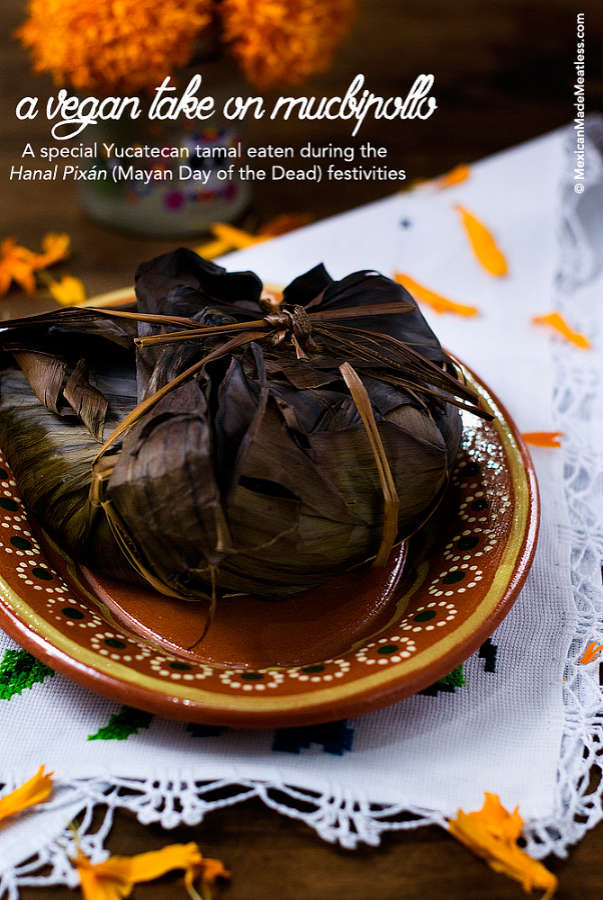
What Are Yucatecan Pibipollo Tamales
These tamales are unlike any other tamales you’ve eaten!
Pibipollo is an ancient Mayan dish that is traditionally only served during the Day of The Day holiday, or Hanal Pixán as it’s called in their dialect.
To make the masa a small local black bean called espelón or x’pelón is mixed into the masa. Also it is seasoned with achiote paste to give it a red color.
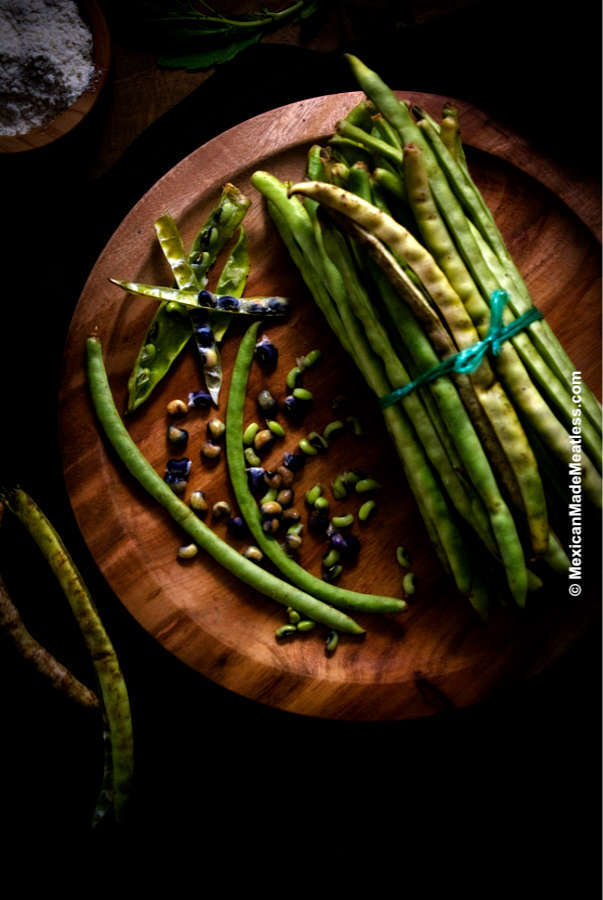
The dish is basically a giant tamal which is shaped like a bowl and stuffed with meats, onion, tomato, chiles, epazote leaves, and a red sauce.
A dough “lid” is placed on top. Then drizzled with a salsa before being wrapped in banana leaves and cooked.
Once wrapped up it is traditionally taken to be cooked in an underground pit (or pib) where it is slowly cooked for hours before being eaten.
So no steamer pots, but of course nowadays most people use the oven instead.
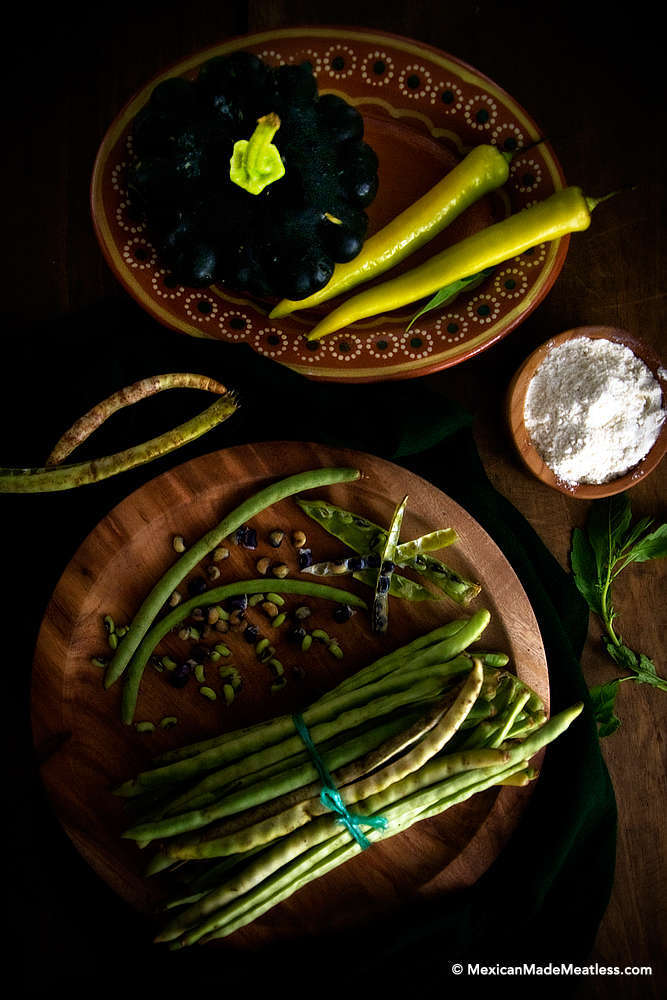
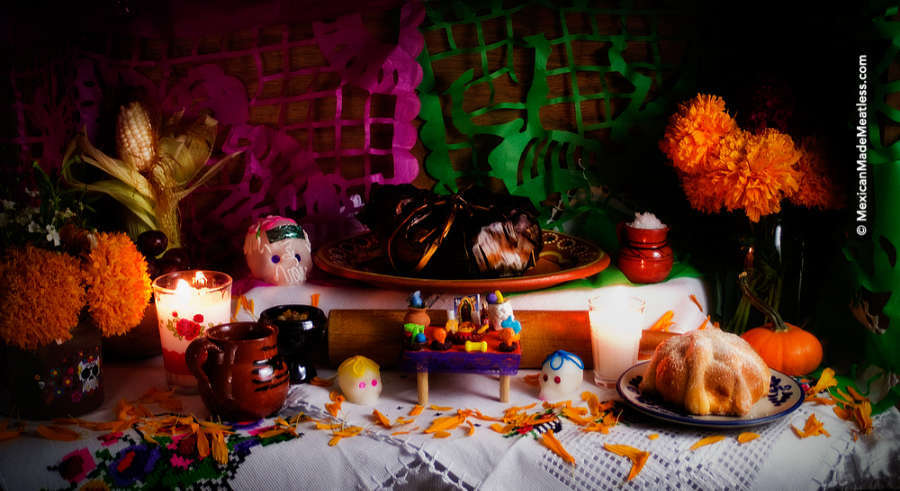
Hanal Pixán or Mayan Day of The Dead
The Maya call their day of the dead Hanal Pixán and the rough translation is “food for souls“.
Needless to say, food plays an important role in their celebrations.
During the later part of October and into November families across the Yucatan prepare this dish called pibipollo or mucbipollo.
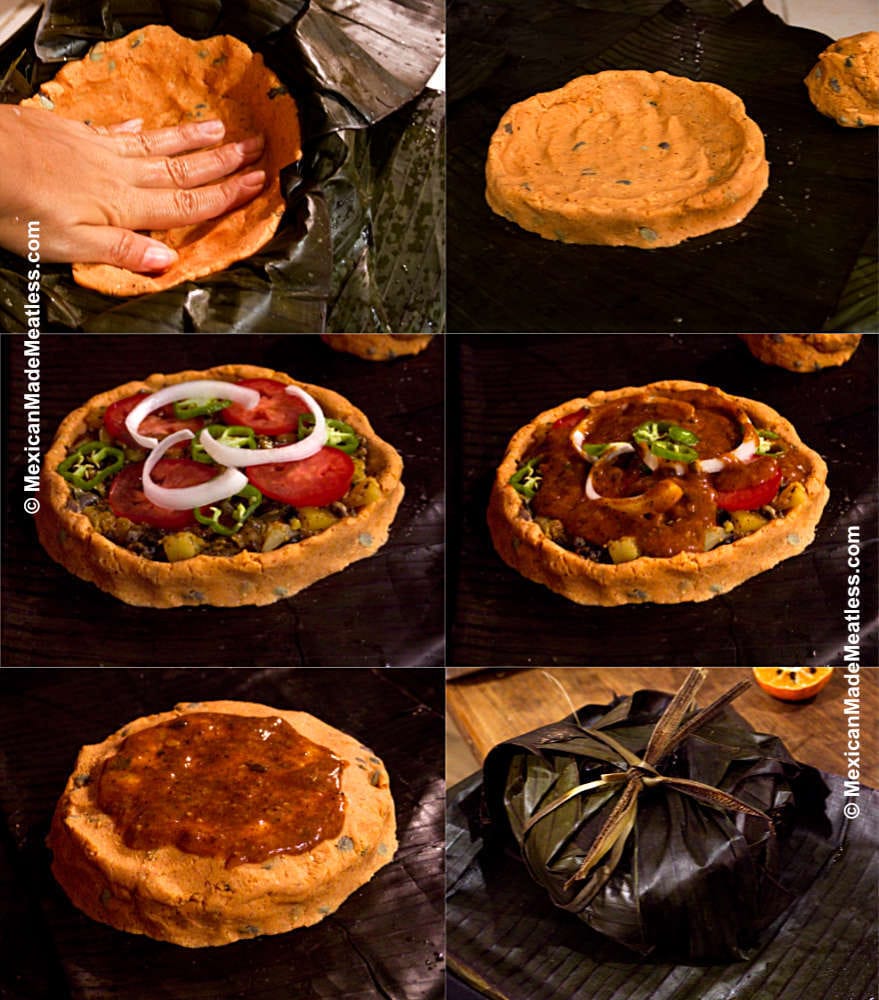
How to make Vegan Pibipollo Tamales for Day of The Dead
Of course the recipe uses meat, but I took on the challenge to make it a meat-free dish.
Just coincidentally it became vegan — which probably isn’t too far from the ancient recipe since ingredients like pork and lard where introduced to the native diet by the Spanish.
It’s believed that the indigenous diets were heavily meat-free ones prior to the conquest. I did very extensive research to try to stick to the traditional recipe as best as possible, and I think I did a pretty good job at it too.
My filling was made of entirely vegetables like potato, green pattypan squash, spinach, and a special seasonal young bean from the region called expelon (or espelon). But don’t worry you can use black beans instead.
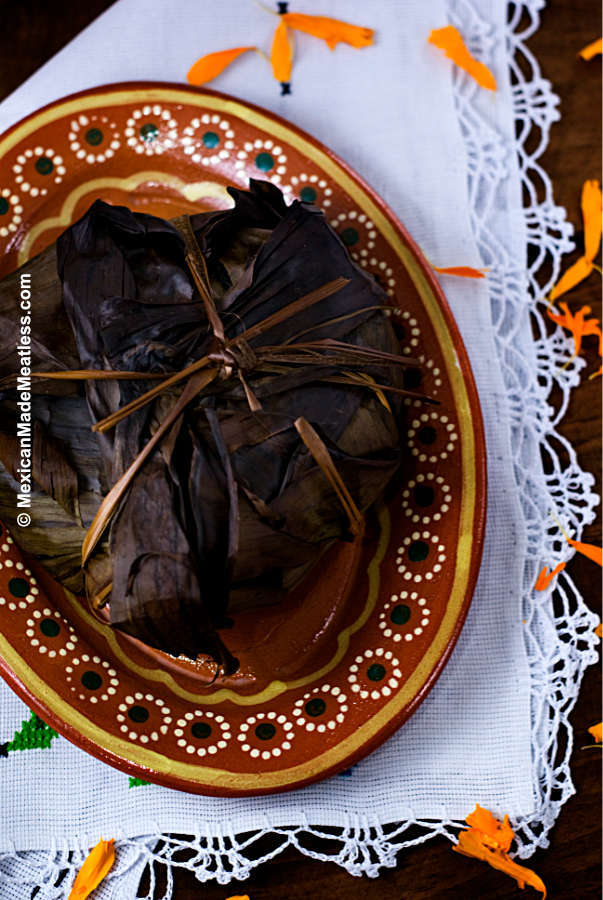
If you can’t find the green pattypan you could use zucchini or even pumpkin, if you’d like.
The tamales have a reddish hue, this is due to the achiote (or annatto) paste (also called recado rojo). The paste not only gives it the colour but also much of the dish’s flavour.
It is a tart, slightly smokey and aromatic spice that is very commonly used in the cuisine of the Yucatan — you may have seen it used for cochinita pibil, the slow roasted pork dish.
You can buy the achiote paste at your local Mexican food store or even online through Amazon. The banana leaves can also be purchased at Hispanic, Caribbean, or any Asian food market. Typically you’ll find them frozen, so all you do is defrost them.
Okay, let’s get to the recipe then I’ll tell you how mouthwatering this vegan pib tasted!
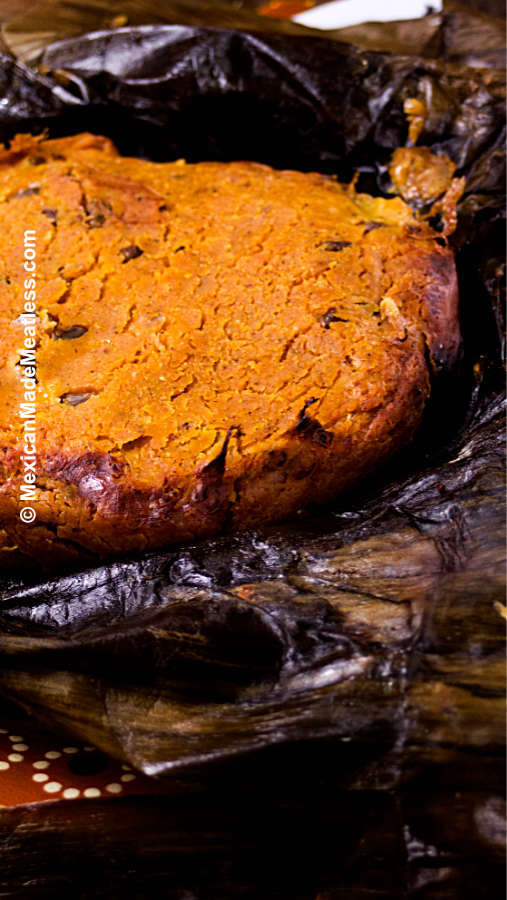
Yucatecan Vegan Tamales for Day of The Dead (Pibipollo Vegano)
Ingredients
Tamales Filling Ingredients
- 1 large green patty pan squash (weight is 1.32 lbs about one large) cut into even-sized bitesize pieces or substitute with zucchini or pumpkin,
- 1 lb potatoes, cut into even-sized bitesize pieces it was two medium-large potatoes
- 2.9 oz of finely chopped white onion
- 3 large cloves of garlic roughly minced
- 3.5 oz frozen spinach weigh after thawed and all excess water is squeezed out
- 7 oz cooked black beans
- 5 cups low-sodium vegetable broth
- 1/2 teaspoon of ground black pepper
- 1 teaspoon of ground cumin seed
- 1 teaspoon of crushed dried Mexican oregano
- 1 teaspoon of dried epazote leaf or replace with dried parsley
- fine sea salt to taste start with 1 teaspoon because the achiote paste is salty too
- 2 Tablespoons of olive oil or vegetable oil of choice
Ingredients for the Sauce
- 1.5 Tablespoons of achiote paste
- 1 cup of water
- 3 Tablespoons of dried corn masa
Ingredients for the Masa
- 1 lbs of instant corn flour for tamales like Maseca brand
- 1 teaspoon of fine sea salt
- 1.5 cups vegetable oil I used canola oil
- 2 to 3 cups of low-sodium vegetable broth or water amount will depend on humidity in your kitchen
- 1 Tablespoon of achiote paste
- 3.5 oz of black beans
- large pack of banana leaves
Ingredients for Topping The Filling
- freshly sliced red tomatoes as needed
- thinly sliced white onion as needed
- thinly sliced habanero pepper or a milder chile may also be used, as needed
Instructions
Instructions
- In a large pot heat up the oil, once hot add the onion and saute until soft. Next add the minced garlic and saute for a minute, then add the potatoes and fry for about 5 minutes. Next add the patty pan or pumpkin and cook for a few more minutes (If using regular zucchini add at step 2). Carefully pour in the broth, sprinkle in the seasonings and allow to simmer until the vegetables are soft — but not mushy.
PREPARING THE KOL OR SAUCE
- While you wait for the veggies to cook combine all of the ingredients from the kol or sauce list. This will make a thickish mixture that you’ll use in step 4.
PREPARING THE MASA OR DOUGH
- Next prepare the masa (or dough) by combining the achiote paste with the 2 cups of broth and oil in a bowl. Whisk or stir until the paste has completely dissolved. Now in a large bowl combine the corn flour with the salt, then little by little begin mixing the liquid mixture into the flour. Use your hands to work the liquid into the flour and continue to add more until you achieve a dough with the consistency of play dough — not too dry, and not too wet. Lastly add the cooked black beans from the masa ingredients list and work them into the dough until they are distributed throughout. Cover the bowl and set aside.
CONTINUE COOKING THE FILLING AND PREPARING THE SAUCE
- Once the vegetables are soft, add the cooked beans and the spinach (if using regular zucchini add now) to the pot. Then pour in the mixture from step 2 and simmer under low heat for 10 minutes. After this very carefully separate the cooked vegetables from the broth by placing a large colander over a big bowl or large pot, and draining the broth into the bowl or pot. You need to reserve both! Once the veggies have drained off the liquid set them aside and pour the liquid back into your cooking pot. At this time taste this broth and if needed add more salt or any of the seasonings from the filling ingredients list. Next, over medium-low heat gently simmer this leftover reddish broth until it becomes thick like a gravy. Depending on how humid it is where you live you may or may not need to add another tablespoon or two to the broth in order for it to thicken up.
PUTTING THE TAMAL TOGETHER
- While you wait for the sauce to thicken up preheat the oven to 200°C or 392°F and have a large baking sheet ready. You can either make the whole pibipollo in a large deep baking dish, or you can prepare 4 individual sizes like I did (which aren't too small). The process will be the same but if you will do the one large then the process isn't repeated, of course.
- Once the sauce has thickened up you can start shaping the tamales. If making one large tamal then set about one quarter of the dough aside to make the lid. If making 4 individual tamales then separate the dough into 4 equal parts, from each of these four pieces remove one quarter to make the lid. With each piece make a ball. If making the one large tamal, layer the baking dish with banana leaves until they cover the entire dish and even fall off the sides. If making the 4 smaller ones lay a large piece or two of banana leaf on your working surface. Place the dough ball on the centre of the banana leaf and use your fist and hands to form a bowl just like you see in the photos. Next scoop in some of the vegetable filling and spread it around the cavity of your dough bowl to create an even layer. Then arrange slices of tomato, onion, and the chile around the top of the filling. Next ladle some of the red sauce over each tamal and smear it around.
- Next take that remaining quarter piece of dough and lay it on another piece of banana leave. Use your palms and fingers to flatten the masa and create a flat thin disk that is large enough to cover your tamal bowl. If you’d like you can spread a little bit of the red sauce over the top before proceeding. Once ready carefully place the flat disk over the filled tamale and pinch it around the edges to seal it. Now as best as you can fold the edges of the banana leaf that you placed your tamal on, to create a wrapping. Carefully lift the wrapped tamal onto your baking sheet and continue until all four are prepared, once they are place in the oven and bake for 2 hours. Keep an eye on it because the banana leaves will crisp up and smell like their are burning.
- After baking your tamal or four tamales, leave them to rest for 10 minutes so they can cool down and be handled. When ready to serve place each one on a serving plate and carefully cut away the banana leaf wrapper to expose the tamal. Since this one is bake the texture will be firmer and a bit drier — in fact the top crust will even crisp up but be tender in the inside.
- Refrigerate any leftovers for up to one week and you can also freeze the uncooked pibipollo for a few months if desired.
Notes
Traditionally this dish is prepared with a local variety of squash, but any of the mentioned alternatives work well. The espelon black beans that are typically used are not easily found outside of the region, but regular black beans will work. You can make this dish as spicy or mild as you like. For the extra spicy version use slices of habanero chilies, for a medium heat use serrano peppers, and for a milder version use jalapeno peppers.
Nutrition
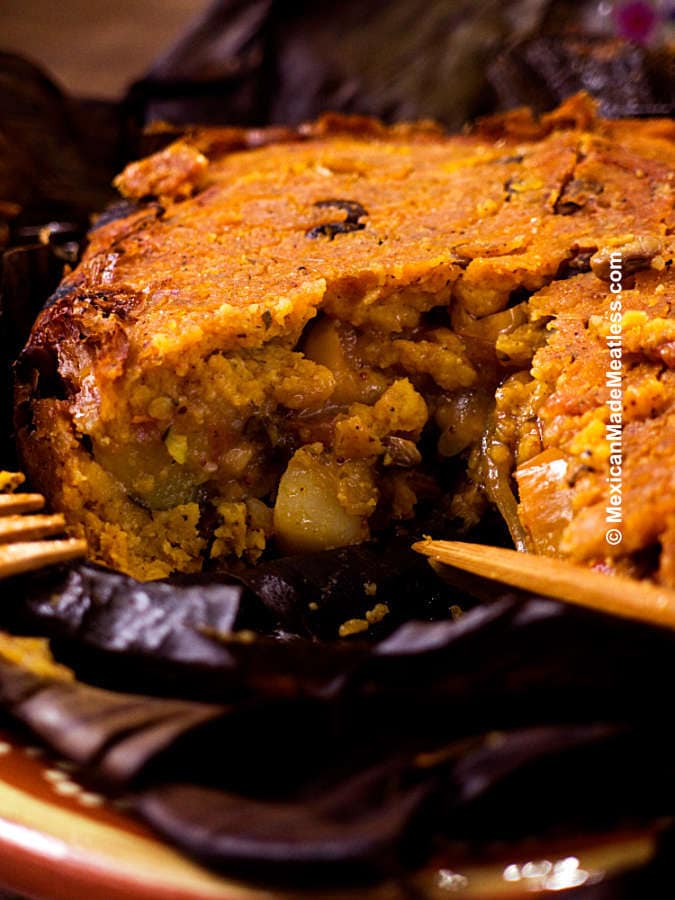
Yes the ingredients and the steps are many. But it actually doesn’t take that long to prepare and the hardest part is waiting for it to cool down so you can dig in.
These Day of the Dead vegan tamales taste smokey, earthy, savoury, and you could really taste the tender vegetables that paired so well with the flavours of the slightly tart achiote paste.
The outer crust was crispy but inside it was tender and oozing with the vegetables and sauce. It’s unlike any other dish, and certainly tamal, that I have ever eaten. I really do hope you make it to see for yourself.
Nancy Lopez is a food blogger and author of the cookbook Mexican Tamales Made Meatless. Born in Mexico, raised in the US, and currently living in Southern Mexico, she has followed a meatless diet for almost 10 years. It is her passion and mission to share all she has learned about vegan Mexican cooking and vegetarian Mexican recipes. Mexican Made Meatless is a blog dedicated to preserving the authentic flavors of Mexican cuisine just without the meat. It’s a place to celebrate Mexican culture and all it’s delightfully delicious traditional foods. Read more…

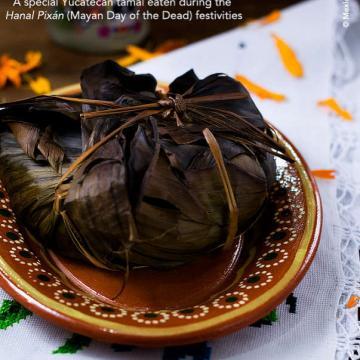
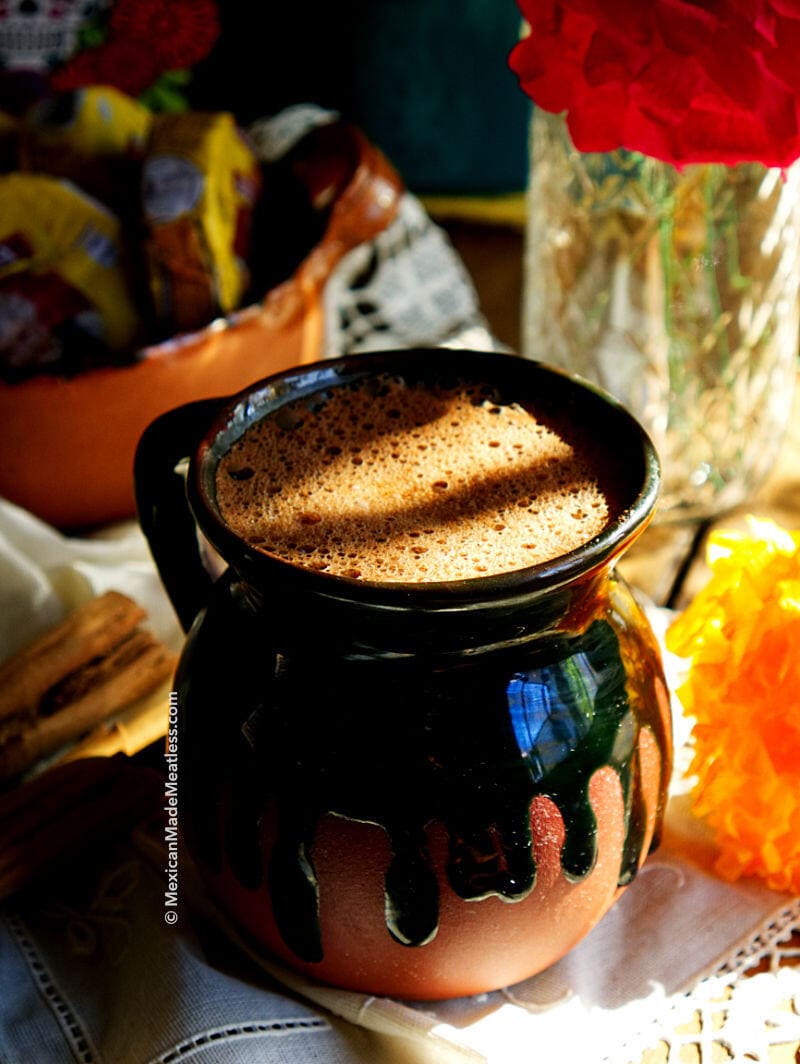
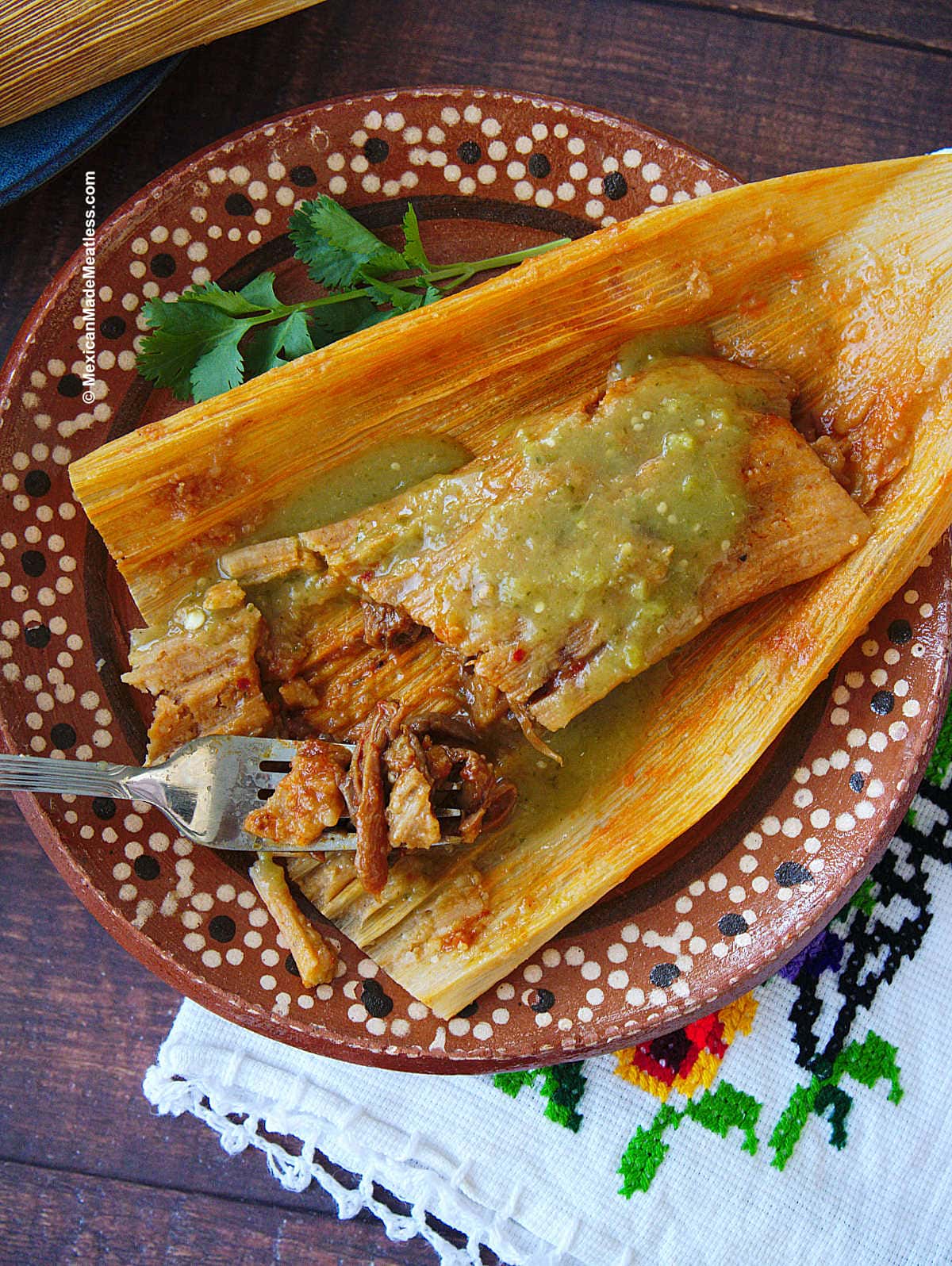
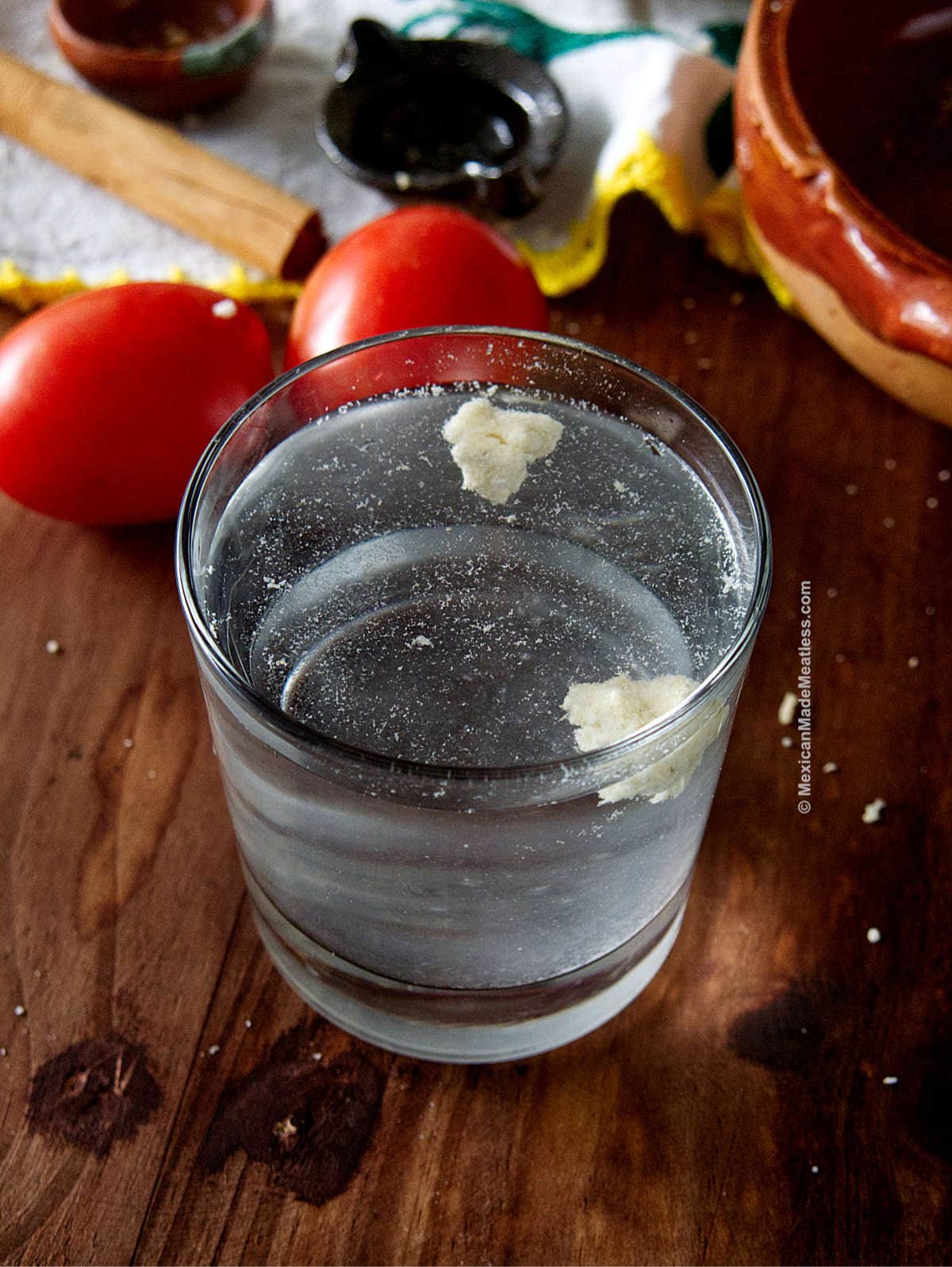
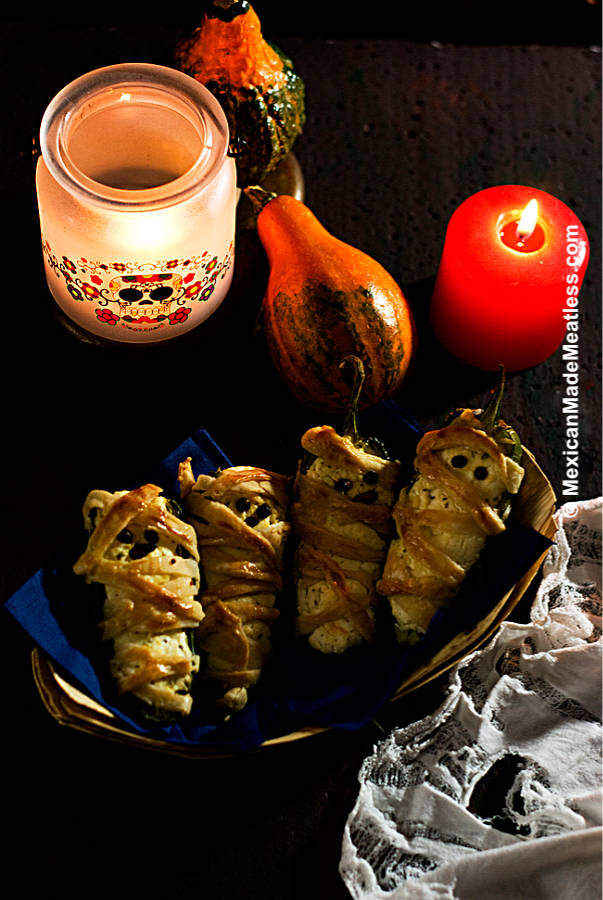
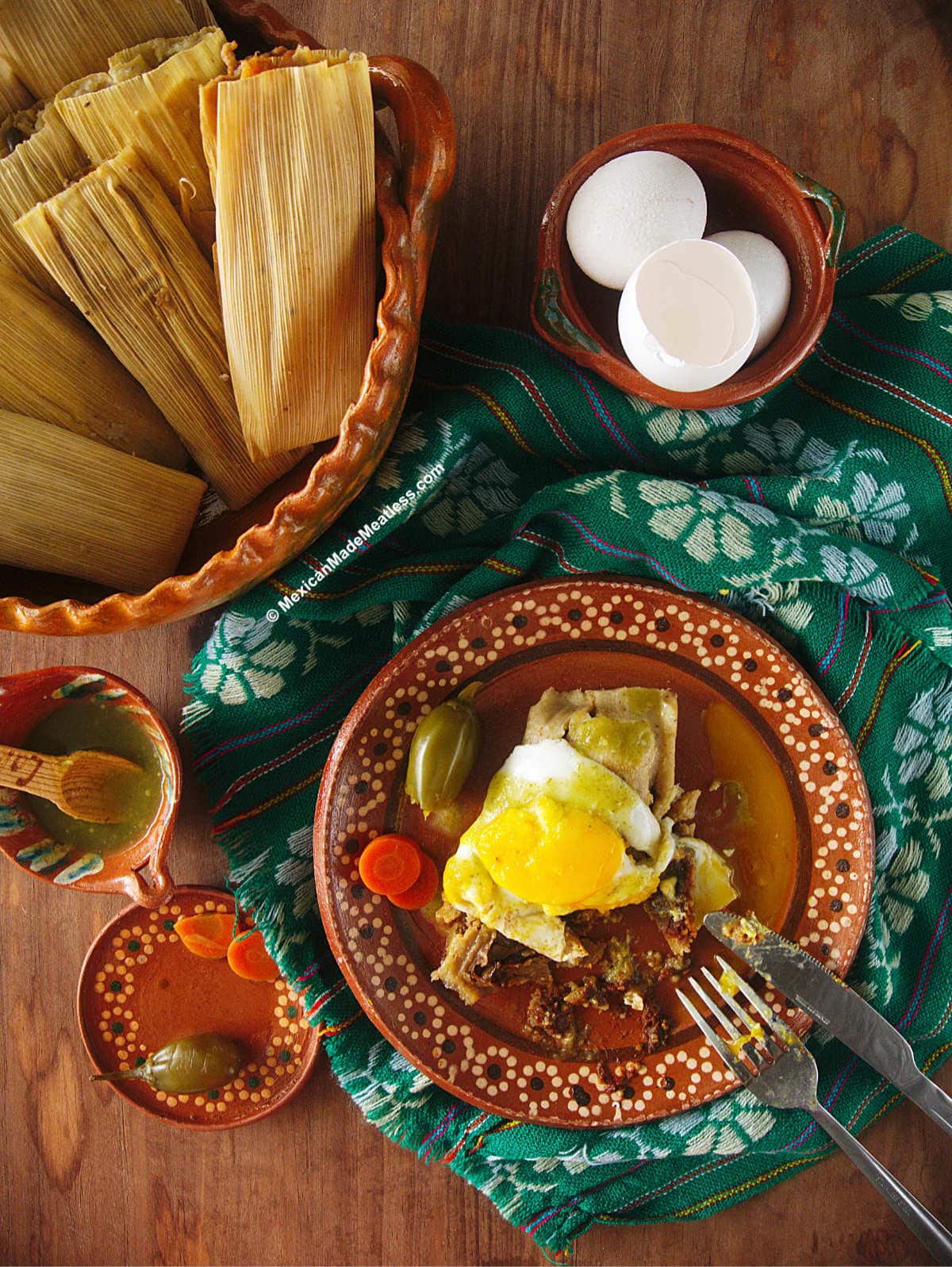
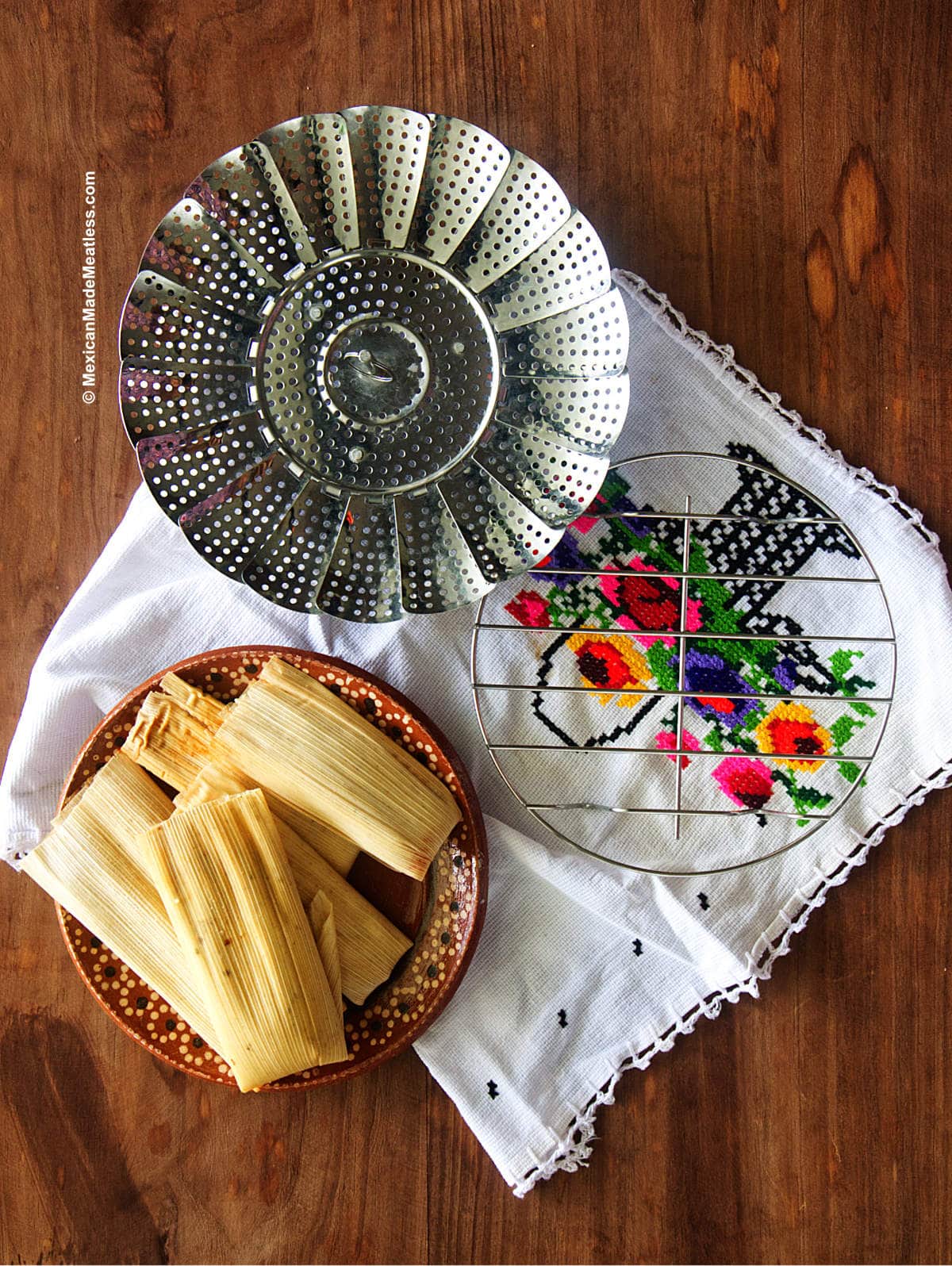
Nancy, esto se mira delicioso.
Muchas gracias, que linda te lo agradezco mucho!
Soy de Mérida y como vegano, me encanta saber que es posible preparar un mucbipollo vegano. Gracias por compartir!
Hola Eugenio! Muchas gracias y espero que te guste. Buen provecho.